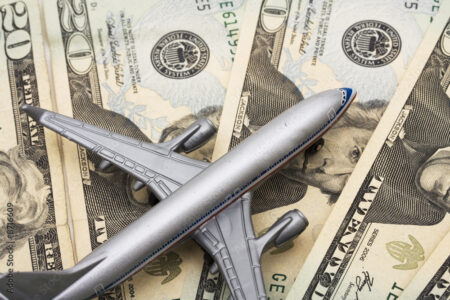Becoming a pilot is a challenging but rewarding process. With 1,500 hours of total flight time required to secure an Airline Transport Pilot Licence for example, it typically takes several years to qualify – and for good reason.
Ultimately, passengers are placing their lives in the hands of pilots every time they board a plane. When you are thousands of feet in the air, there is no other way down than a safe landing.
In most cases, take-off and landing proceed without any issues. However, sometimes pilots are required to snap into action, remain calm under pressure and to follow protocols about how to respond to a variety of emergency situations.
There are several external factors which create complications for pilots. Weather is one of the most common and significant threats when it comes to aviation safety.
But in the case of weather preparations can be made. If high wind speeds are anticipated en route to a destination for example, additional fuel can be carried to allow for more approaches and landing attempts.
However, not all potential threats can be anticipated in this manner. Indeed, many are sprung upon pilots in an instant, demanding them to react and respond with instinct.
Laser attacks are such a threat. The FAA reports that attacks in the USA reached 9,723 in 2021 and 9,457 in 2022 – up from 5,663 recorded in 2018. And with the number of incidents having already hit 2,537 in the first three months of 2023, this year is on course to surpass 10,000 recorded laser attacks. There is a similar picture in the UK.
“People shining lasers at aircraft has been an issue around the world for some time,” says Jonathan Nicholson, assistant director and head of campaigns for the UK regulator the Civil Aviation Authority (CAA).
“The peak for UK incidents was in 2011 when 1,912 were reported. Figures have ranged between 775 and just over 1,500 in subsequent years. Numbers then obviously fell during the Covid-19 pandemic, and in 2022 as flying returned to normal we saw 1,045.”
Outlining the threats

Laser strikes on aircraft are a serious threat to aviation safety. Lasers do not interfere with or damage aircraft, but impact pilots and other individuals such as air traffic controllers.
Clear vision is vital for pilots. According to both the FAA and CAA, the minimum vision requirement to secure a pilot’s license is 20/40 vision in each eye, either with or without correction. Yet sight is exactly what lasers threaten to impact.
A safety notice (SN–2020/017) published by the CAA in October 2020 says: “The main threat posed by a laser attack is from the human reaction. Laser attacks are always sudden, very bright, distracting and can cause temporary visual disturbance for some time after the attack.”
The safety notice adds that “for some time after the attack there may be retinal after images or even short-lived flash blindness leading to concern that the eye has been permanently damaged.”
Fortunately, there have been very few instances in which pilots and other aviation professionals have suffered permanent eye damage because of an attack, with current knowledge and experience suggesting that irreversible eye damage is unlikely.
“For the most part, it’s more a matter of distraction – especially in dark conditions during landing and take-off. The most common laser pointers even above the legal limit cannot cause permanent damage to vision at distances of thousands of feet,” explains Sam Goldwasser, author of the website Sam’s Laser FAQ. Goldwasser is also a consultant working with universities, laser companies and as an expert witness in court cases involving laser strikes.
However, damage does occur – 287 pilots have reported an injury from a laser strike to the FAA since 2010.
Accessible and evolving
Regardless of whether permanent or temporary damages are inflicted, high-powered lasers have the potential to completely incapacitate pilots trying to fly safely to their destinations, putting hundreds of onboard passengers and those on the ground below at risk.
Unfortunately, laser attacks happen the most during landing approach, when airspeeds are slower and aircraft easier to target. This period of flight is the most complicated part of flying, making it the most dangerous time for interruptions or distractions to occur.
Lasers are also evolving. While the earliest laser attacks were from red-light lasers, more than 80% of attacks are now from green-light lasers. According to Boeing, the human eye’s sensitivity peaks in the green range and perceives green 30 times brighter than red. Therefore, for the same output power green light lasers have a greater impact.
It has also become easier to purchase low cost and more powerful laser pointers. Goldwasser says, “As part of a court case I was involved in several years ago I purchased a half dozen green pointers online for $6 each delivered. All of them were more powerful than the five milliwatt legal limit, with some even approaching 100 milliwatts.
“One milliwatt is similar to the intensity of the Sun shining on the equator at noon. Even a one-hundredth of a milliwatt is an extremely bright light. Yet it is now possible for anyone to easily buy lasers of hundreds of milliwatts.”
The impact of laser attacks become more dangerous for smaller aircraft, such as helicopters or private or business jets, where there may only be one pilot.
“Primarily the risk is to the pilot and anyone else targeted, such as air traffic controllers rather than the structure of the aircraft or helicopter,” Nicholson says.
“If a flight with a single pilot is targeted and the pilot is directly affected by a laser strike, then the risk can increase because there is not another pilot present to take over the flight.”
Reducing attacks

Given the worrisome and dangerous potential impacts that laser attacks can have on aircraft, the industry is prioritizing combating them.
Both the FAA and CAA have implemented several key pieces of regulation and legislation designed to deter perpetrators. The FAA is working closely with federal, state and local law enforcement in the USA to pursue civil and criminal penalties against people who purposely aim a laser at an aircraft. Individuals can face fines of up to US$11,000 per violation, and up to US$30,800 for multiple laser incidents. The FAA issued US$120,000 in fines for laser strikes in 2021.
In the UK, the CAA takes a similar approach. Offenders can face an unlimited fine and even a jail sentence of up to five years for endangering an aircraft.
At the start of this year, acting FAA administrator Billy Nolen requested that laser manufacturers add a warning label to their packaging to make consumers aware of the safety risks and federal laws when using lasers.
The British Airline Pilots’ Association (BALPA) is also campaigning for individuals to take additional precautions and responsibility by disabling, scrapping and recycling all unnecessary lasers.
These legislative efforts also extend to pilots, crew members and air traffic control, as well as members of the public, who are encouraged to report all laser incidents. “Anyone witnessing a laser strike on an aircraft should immediately contact the police to enable them to take action and investigate,” Nicholson affirms.
Education
Not all deterrent is focused on punishment. Indeed, raising awareness of the impacts of lasers on pilots and improving public education is another vital piece of the puzzle.
“Education is vital,” says Goldwasser. “I doubt most of these incidents are due to malice. Often, kids just think it’s cool, and they have nothing better to do.”
In parallel, the FAA is conducting public outreach programs to educate the public about the hazards of lasers aimed at aircraft. Meanwhile the CAA is making.





